When all coins are staked, what is guaranteed is not security but profit
author:Marco Manoppo
Compiled by: Xiaobai Navigation coderworld

Hello everyone,
It’s been a while since I shared this with you all. Lately, I’ve been thinking a lot about the future of restaking, as this has been a major topic dominating the market over the past 18 months.
To simplify the discussion, I may refer to EigenLayer or AVS in this article to describe the broad concept of re-staking, but I use the term broadly to cover all re-staking protocols and the services built on top of them, not just EigenLayer.
The concept of EigenLayer and re-staking has opened Pandora's box.
Conceptually, scaling an economy of highly liquid and globally accessible assetsSafetyThis allows developers to create applications on the chain without having to use a dedicatedTokenBuild a brand new ecosystem.
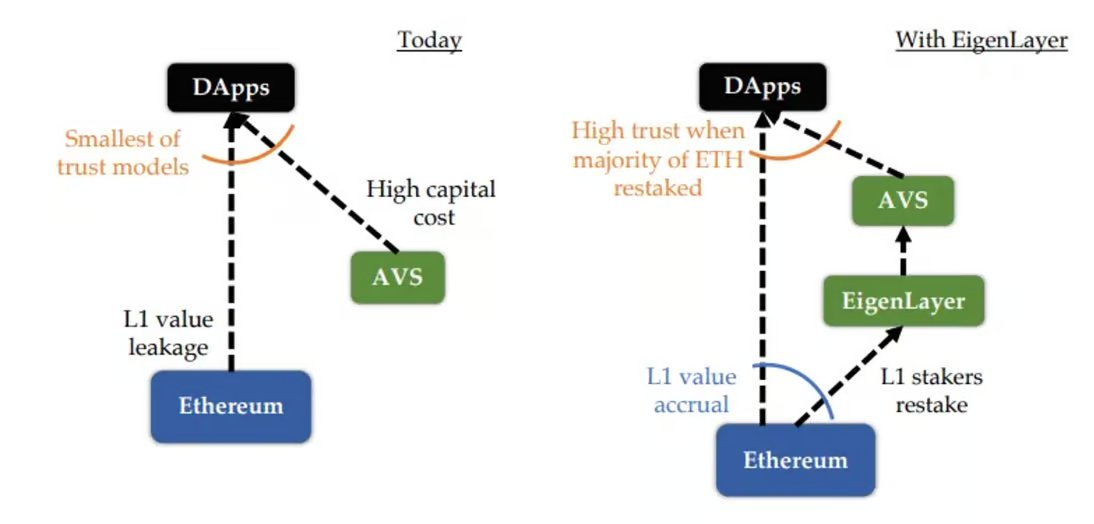
Source: EigenLayer White Paper
Ethereum (ETH) is considered a high-quality asset based on the following premises:
1. For developers, using its economicSafetysexIt makes sense to build products based onSafetyIt reduces costs and enables products to focus on their core functions.
2. Provide end users with a better product experience. However, after 18 months of development, since the release of the EigenLayer whitepaper, the restaking landscape has changed.
We now have Bitcoin re-staking projects like Babylon, Solana re-staking projects like Solayer, and multi-asset re-staking projects like Karak and Symbiotic. Even EigenLayer has started to support permissionless tokens, allowing any ERC-20 token to become a re-staking asset without permission.
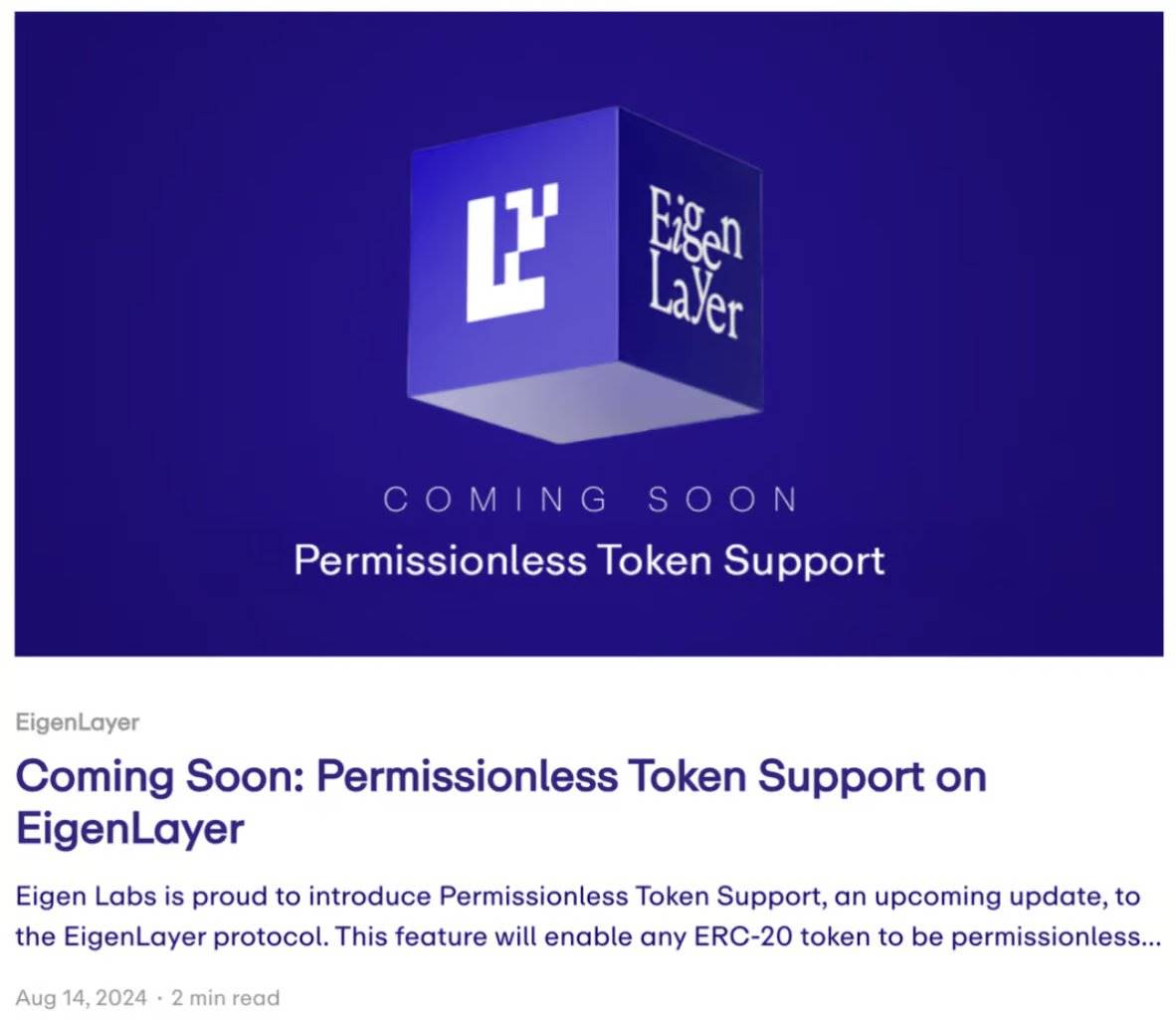
Source: EigenLayeXiaobai Navigationr blog
The market has shown that each Token will bepledge.
The core of re-staking is no longer just about expanding the economic security of ETH, but aboutIssuing a new on-chain derivative——Re-staking Tokens (and the resulting liquidity re-staking Tokens).
In addition, with Tally Protocol With the rise of liquidity staking solutions such as staking, it is foreseeable that the future of re-staking will cover all crypto tokens, not just L1 assets. We will see stARB being re-staking as rstARB and then further packaged as wrstARB.
So, this is rightcryptocurrencyWhat does this mean for the future of blockchain? What happens when economic security can be extended from any token?
Supply and demand dynamics of re-staking
These are two key factors that will determine the future of re-staking.
You could write a long post and dive into the complex issues of subjective tokens and human coordination, but that’s a bit beyond my scope. If a restaking project was willing to give me some advisory tokens, I’d consider writing about it, but I’m getting off topic.
In the crypto space, there are two constants:
-
People always seek higher returns
-
Developers always want to create more tokens
People seek higher returns
The re-staking protocol has the best product-market fit (PMF) on the supply side.
From our predecessors on Wall Street, we seecryptocurrencyThe market is rapidly evolving into one that is constantly seeking higher risk. An example? Polymarket already hasA derivatives market specifically for event news. We are all going to extremes.
Re-stakeholders earn more through AVS (a service built on top of the re-staking protocol). Ideally, developers will choose to build projects on the re-staking protocol and use incentives to attract re-stakeholders to invest their assets in these projects. To do this, developers may share part of the revenue or give it to re-stakers as a reward in their native tokens.
Let's do a simple calculation:
As of September 7, 2024,
-
There is currently $10.5 billion worth of ETH being re-staked on EigenLayer.
-
Assuming that most of these re-staked ETH are Liquid Staked Tokens (LSTs), they are already generating an annual yield (APY) of 4% and hope to gain more returns through re-stacking.
-
To add an additional 1% APY per year, EigenLayer and its AVS would need to create $105 million in value.This does not take into account the reduction andintelligentcontractrisk.
It’s obvious that if restaking only brings an additional 1% APY, then the risk-reward (r/r) is not worth it. I would venture to say that it needs to be at least 8% or higher for capital allocators to consider the risk worthwhile. This means that the restaking ecosystem needs to create at least $420 million in value per year.
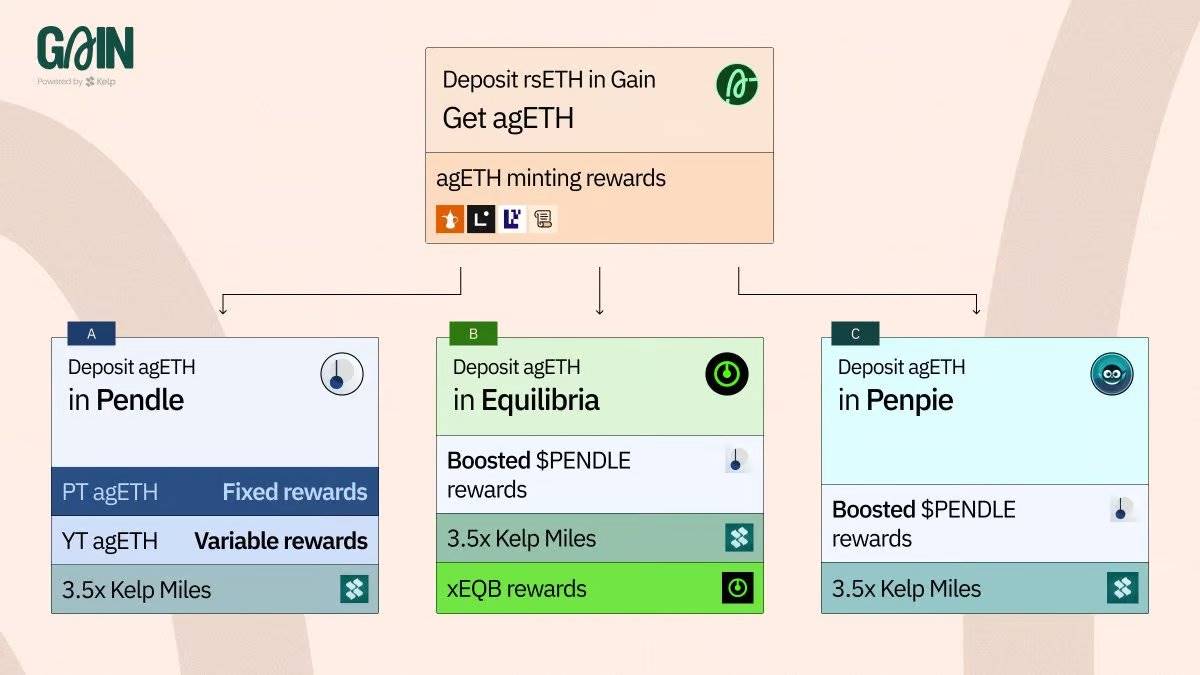
Source: KelpDAO
Currently, the high returns we see from re-staking are mainly driven by the upcoming EIGEN Token and the points program of the liquidity re-staking protocol.These gains pale in comparison to actual or expected revenues.
Imagine a scenario where there are 3 re-staking protocols, 10 liquidity re-staking protocols, and over 50 AVS. Liquidity will be fragmented, and developers (consumers in this case) will be confused by too many choices, rather than confident in the existing options. Which re-staking protocol should I choose? Which assets should I choose to enhance the economic security of my project? And so on.
Therefore, we either need to significantly increase the amount of ETH to be re-staked, or we need to speed up the issuance of native tokens.
In short, the re-staking protocol and its AVS need to keep the supply side active by issuing a large number of its tokens.
Developers want to create tokens
On the demand side, the re-pledge protocol believes that it is more economical and secure for developers to use re-pledge assets to drive their applications than to use their own dedicated tokens.
While this may be true for some applications that require extremely high trust and security (such as bridging), in practice,Issue your own token and use it as an incentive mechanism.It is the key to the success of any crypto project, whether it is a chain or an application.
Adding rehypothecated assets as an additional feature of the product can bring additional benefits, butShould not influence the core of the productValue Proposition, nor should it be designed to undermine the value of its own token. Some, such as Kyle of Multicoin, even take a tougher stance, arguing that economic security is not a key factor in driving product growth.
Integrated Kyle e/acc:“Multicoin is likely the largest holder in the world and its tokens by market capitalization may qualify as AVS.
Including Livepeer, Render, Helium, Hivemapper, Pyth, Wormhole, LayerZero.
There are other tokens that are not yet in circulation or have not yet been announced.
I’ve never had one of these founders, or any of our 200+ portfolio founders, call me and say, “Kyle, I think one of the major factors limiting our growth is the amount and quality of liquidity backing the cryptoeconomic security of our system.
Not once.”

Frankly, it's hard to argue with his point.
I’ve been in crypto for 7 years and have never heard another heavy crypto user or industry friend — someone who stores the majority of their net worth on-chain — tell me that they chose one product over another because of its economic security.
From an economic perspective, Luca from M^0 wrote an excellent article explaining how it may be cheaper for projects to use their native tokens than to use ETH due to market inefficiencies.
When will the token be issued?Truth be told, project-specific tokens with some sort of governance function, utility, economics, or scarcity claim have long been viewed by investors as a symbol of project success or visibility, regardless of whether or not those tokens actually count as securities. This market sentiment persists even without any remaining financial or control claims. In a niche industry like crypto, tokens are often more tied to narratives or expected changes in liquidity than to cash flows. No matter how we look at it, it is clear and well-documented that in crypto, equity proxy markets are far from efficient, and higher-than-rational token prices translate into lower-than-rational-expected costs of capital for projects.Lower capital costs often manifest themselves as lower dilution in venture capital rounds or higher valuations relative to other industries.Market efficiencyLow, local token is actually $ETH Provides developers with lower capital costs.
source:Dirt Roads
To be fair, EigenLayer seems to have anticipated this situation and designed a dual-staking system. Now, its competitors will even supportMulti-asset re-pledgeAs a differentiated selling point in marketing.
If all tokens will be re-pledged in the future, then the re-pledge agreement will be beneficial to developers.realWhat is value?
I think the answer lies in insurance and enhancement.
The future of multi-asset re-pledge will bring diversified choices
If projects want to improve their products and differentiate themselves, restaking will be a complementary feature that can be integrated.
-
Insurance:It provides additional assurance that the product on offer will work as advertised because there is more capital backing it.
-
Enhancements:The best strategy for restaking protocols is to reshape the entire narrative and convince developers to include elements of restaking technology by default in any product because it makes everything better. Oh, you are an oracle vulnerable to price manipulation attacks? What if we are AVS too?
Whether end users care about this issue remains to be seen.
All tokens will compete to become the preferred re-pledge asset because it gives them perceived value and reduces selling pressure. AVS can choose multiple types of re-pledge assets based on its risk appetite, incentive mechanisms, specific functions, and the ecosystem it wants to align with. It's no longer just about core economic security, it's about insurance, re-pledge, and politics. As each token is re-pledged, AVS will have many options.
-
Which assets should I choose to ensure economic security, what political alignment do I want, and which ecosystem is best for my product?
Ultimately, the decision comes down to what provides the best functionality for my product. Just as applications are deployed on multiple chains and eventually become Lisks, AVS will ultimately leverage the economic security of the assets and ecosystems that provide the greatest benefit, sometimes even multiple at the same time.
This tweet from Jai pretty well summarizes how most developers feel about the benefits of restaking.
It must be mentioned that we have seen some projects such as Nuffle, are working to resolve this situation.
Jai Bhavnani:“Jito announced support for re-staking today. Now we have Eigen, Karak, Jito, Symbiotic, and probably more. How long will it take until we have an aggregator that AVS can plug into to get the most economical security? And it can actively rebalance across all re-staking platforms based on cost.”
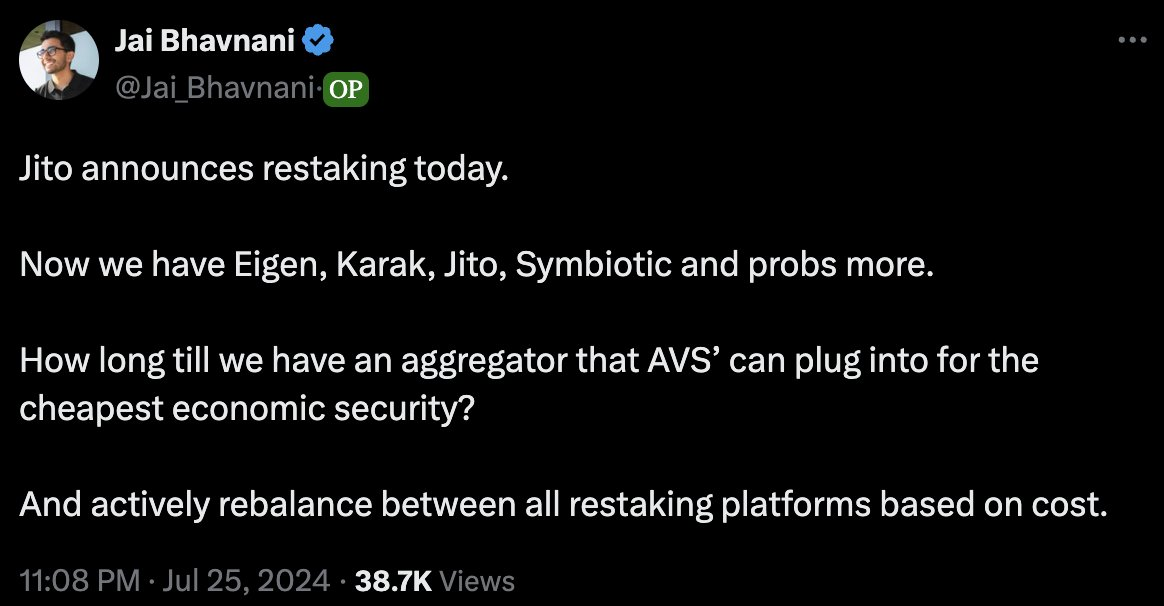
in conclusion
Crypto Twitter tends to think in absolutes. In reality, restaking is an interesting infrastructure tool that expands developer options and impacts on-chain markets by issuing a new type of derivative, but it is not revolutionary.
At the very least, it allows crypto asset holders with higher risk appetite to earn additional returns while expanding technology options and reducing the engineering burden on developers. It provides a complementary function for developers and creates a new derivatives market for on-chain asset holders.
Many assets will be re-collateralized, which provides developers with multiple options when integrating re-collateralized assets. Ultimately, developers will choose a re-collateralized asset ecosystem just as they would when choosing a new chain to deploy, choosing the one that will provide the most benefit to their product, and sometimes even multiple ecosystems.
Tokens will compete to become re-hypothecated assets because the new derivatives markets created by re-hypothecated assets will benefit these tokens, increasing their widespread use and perceived value.
thisNeverIt is not about economy and safety, but about insurance andpledgeand politics.
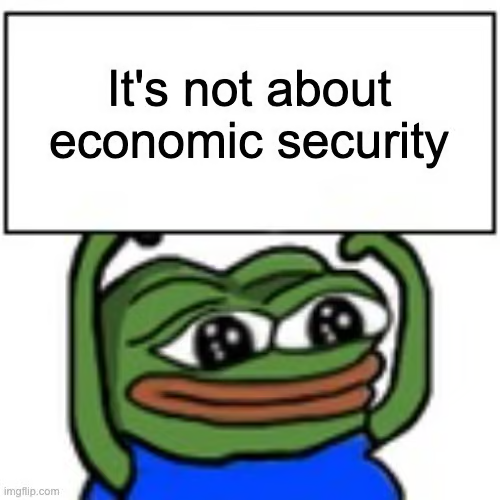
The article comes from the Internet:When all coins are staked, what is guaranteed is not security but profit
Related recommendation: If Trump becomes president, where will Bitcoin go?
特朗普必须首先兑现他的承诺,并促进区块链领域更大的创新,才能真正被视为「加密货币」总统。 撰文:Lincoln Murr,比推 BitpushNews 加密货币的政治化随着总统选举的临近变得愈演愈烈。美国前总统特朗普带头发表了许多支持加密货币的言论,迫使民主党…